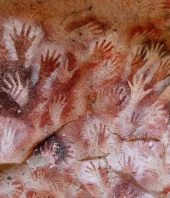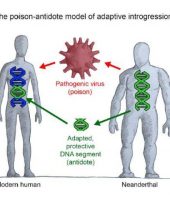Most people associate Africans with dark skin. But different groups of people in Africa have almost every skin color on the planet, from deepest black in the Dinka of South Sudan to beige in the San of South Africa. Now, researchers have discovered a handful of new gene variants responsible for this palette of tones.
The study, published online this week in Science, traces the evolution of these genes and how they traveled around the world. While the dark skin of some Pacific Islanders can be traced to Africa, gene variants from Eurasia also seem to have made their way back to Africa. And surprisingly, some of the mutations responsible for lighter skin in Europeans turn out to have an ancient African origin.
“This is really a landmark study of skin color diversity,” says geneticist Greg Barsh of the HudsonAlpha Institute for Biotechnology in Huntsville, Alabama.
Researchers agree that our early australopithecine ancestors in Africa probably had light skin beneath hairy pelts. “If you shave a chimpanzee, its skin is light,” says evolutionary geneticist Sarah Tishkoff of the University of Pennsylvania, the lead author of the new study. “If you have body hair, you don’t need dark skin to protect you from ultraviolet [UV] radiation.”
Until recently, researchers assumed that after human ancestors shed most body hair, sometime before 2 million years ago, they quickly evolved dark skin for protection from skin cancer and other harmful effects of UV radiation. Then, when humans migrated out of Africa and headed to the far north, they evolved lighter skin as an adaptation to limited sunlight. (Pale skin synthesizes more vitamin D when light is scarce.)
Previous research on skin-color genes fit that picture. For example, a “depigmentation gene” called SLC24A5 linked to pale skin swept through European populations in the past 6000 years. But Tishkoff ’s team found that the story of skin color evolution isn’t so black and white. Her team, including African researchers, used a light meter to measure skin reflectance in 2092 people in Ethiopia, Tanzania, and Botswana. They found the darkest skin in the Nilo-Saharan pastoralist populations of eastern Africa, such as the Mursi and Surma, and the lightest skin in the San of southern Africa, as well as many shades in between, as in the Agaw people of Ethiopia.
At the same time, they collected blood samples for genetic studies. They sequenced more than 4 million single nucleotide polymorphisms (SNPs)—places where a single letter of the genetic code varies across the genomes of 1570 of these Africans. They found four key areas of the genome where specific SNPs correlate with skin color.
The first surprise was that SLC24A5, which swept Europe, is also common in East Africa—found in as many as half the members of some Ethiopian groups. This variant arose 30,000 years ago and was probably brought to eastern Africa by people migrating from the Middle East, Tishkoff says. But though many East Africans have this gene, they don’t have white skin, probably because it is just one of several genes that shape their skin color.
The team also found variants of two neighboring genes, HERC2 and OCA2, which are associated with light skin, eyes, and hair in Europeans but arose in Africa; these variants are ancient and common in the light-skinned San people. The team proposes that the variants arose in Africa as early as 1 million years ago and spread later to Europeans and Asians. “Many of the gene variants that cause light skin in Europe have origins in Africa,” Tishkoff says.
The most dramatic discovery concerned a gene known as MFSD12. Two mutations that decrease expression of this gene were found in high frequencies in people with the darkest skin. These variants arose about a half-million years ago, suggesting that human ancestors before that time may have had moderately dark skin, rather than the deep black hue created today by these mutations.
These same two variants are found in Melanesians, Australian Aborigines, and some Indians. These people may have inherited the variants from ancient migrants from Africa who followed a “southern route” out of East Africa, along the southern coast of India to Melanesia and Australia, Tishkoff says. That idea, however, counters three genetic studies that concluded last year that Australians, Melanesians, and Eurasians all descend from a single migration out of Africa. Alternatively, this great migration may have included people carrying variants for both light and dark skin, but the dark variants later were lost in Eurasians.
To understand how the MFSD12 mutations help make darker skin, the researchers reduced expression of the gene in cultured cells, mimicking the action of the variants in dark-skinned people. The cells produced more eumelanin, the pigment responsible for black and brown skin, hair, and eyes. The mutations may also change skin color by blocking yellow pigments: When the researchers knocked out MFSD12 in zebrafish and mice, red and yellow pigments were lost, and the mice’s light brown coats turned gray. “This new mechanism for producing intensely dark pigmentation is really the big story,” says Nina Jablonski, an anthropologist at Pennsylvania State University in State College.
The study adds to established research undercutting old notions of race. You can’t use skin color to classify humans, any more than you can use other complex traits like height, Tishkoff says. “There is so much diversity in Africans that there is no such thing as an African race.”
Source: AAAS, Full Article






